« May 2010 |
Main
| July 2010 »
 June 24, 2010 | Compose yourself. Antecedent/Consequent thinking
June 24, 2010 | Compose yourself. Antecedent/Consequent thinking

One of the eternal questions of improvisation is "how much of the end product is intentional, and how much is spontaneous?" How many players will recite memorized phrases or entire passages, and how many just make their solos up on the spot? Certainly, the majority employ a combination of creative intuition and strategic, theory-based calculation, but that line between the two can wander, unbeknownst to the audience, and even to the player his/herself.
We plan on dropping in and out of this question over time, but the first approach in this series we'd like to cover is the notion of "antecedent/consequence," otherwise known as "call and response." It's a simple concept really, and you see this demonstrated in early childhood music, and somewhat more primal folk forms.
"Where are you?"
"Here I am."
Simple statement, followed up by a response. The comeback can be a repeat of the question, an answer to it, a diverging reaction, or another related question. "
"WHERE am I?" "I'm right here." "Why do you want to know?"
These are all varied and valid responses, and what happens is a sort of conversation. In improvisation, when you construct your musical "conversations" like some sort of thought out soliloquy, you end up tightening up its larger picture construction. You aren't just blowing notes in some sort of freestyle nonsense. Start with a five note phrase, follow with a restatement of the phrase, either exact repeat or vary one note.
Repeat the phrase backwards. Play only one or two notes from the phrase, or embellish a couple of the notes in the middle.
When you do this, you develop a consistency in your solos. Breaking them up into individual thoughts makes them sound intentional and more sophisticated; you dig yourself a "whole." You can insert small sections of "just blow" time, but a well-crafted, engineered solo demonstrates musicianship and sophistication.
Answer the phone.
Further:
Starting off
Don Stiernberg on the "Big Picture" of improvising
You may quote me on that.
Improvisation: too many choices?
Jazz is an accident.
Posted by Ted at 8:56 AM
 June 17, 2010 | The Theory of Available Tensions
June 17, 2010 | The Theory of Available Tensions
This week, JazzMando staff writer Craig Schmoller, of Groveland Software weighs in on the "Theory of Available Tensions." Some common sense insight from the author of the highly recommended Mando ModeExplorer and JazzCittern ModeExplorer computer software.
A summary of Chord/Scale Theory reduced to a handful of practical Rules of the Road
We all know how goofy I've been about modes and improvisation: My mantra is "The Scale IS the Chord, and the Chord IS the Scale." That's where, in the final analysis, we look at a 7-note scale as nothing but a big chord, and vice versa. Chords are scales stacked up. We use this knowledge to match scales with chords for improvising. And I'm told that the chord/scale approach was championed by the top geniuses at Berklee. But over the years, the folks at Berklee haven't been content to rest on their laurels!
Enter "The Theory of Available Tensions," a distillation of chord/scale behavior and function down to a simple set of rules - A summary of Chord/Scale Theory reduced to a handful of practical Rules of the Road, designed to help keep you in the right lane when navigating hairpin chord changes and avoid-note potholes.

Basically, I look at The Theory of Available Tensions as Chord/Scale Theory with all the avoid notes replaced. Avoid notes are the "unavailable diatonic tensions," if you will. For example, you can't have an 11 on a major seven chord - You can try, but by current rules of the road, your audience will certainly issue a painful citation as they head for the door. No, you would avoid the collision by raising the 11. That's Lydian mode, and the avoid note is, well, avoided.
So if you see a chord, you play the chord tones, and select from the available tensions, for both solos and comping.
Here are the keys. Take it for a spin.
Maj6 7 9 #11
Maj7 9 #11 13
m6 7 9 11
m(Maj7) 9 11 13
m7 9 11 13
m7b5 9 11 b13
Dom7 b9 9 #9 #11(b5) 13 b13
Dom7(sus4) b9 9 #9 13 b13
Aug7 9 #11
Dim7 chord tone raised a whole step yields available tension
Craig Schmoller
Groveland Software
 
Further:
Top Five 'Hover' Tones
Moving Forward; Melodic Progression
4 and 7. The Committal Notes
Some Minor Issues: 'Gravity' Notes in Minor.
Chord Melody: Scratching the Surface
Posted by Ted at 7:11 AM
 June 10, 2010 | Deconstructing Mandolin Picks
June 10, 2010 | Deconstructing Mandolin Picks
 With the recent introduction of our JM Pick Shirt Sale (shameless plug), we've been thinking a lot about picks lately. Despite flirting with a couple newer picks out there like the V-pick or the new Dunlop Americana series, we always find our way back to the JazzMando Proplec 346 pick. The five different features of pick resonate with our needs. Mass seems perfect, that weight and thickness is light enough to manipulate and robust enough for some good tone pull. With the recent introduction of our JM Pick Shirt Sale (shameless plug), we've been thinking a lot about picks lately. Despite flirting with a couple newer picks out there like the V-pick or the new Dunlop Americana series, we always find our way back to the JazzMando Proplec 346 pick. The five different features of pick resonate with our needs. Mass seems perfect, that weight and thickness is light enough to manipulate and robust enough for some good tone pull.
It's safe to say that a majority of mandolinists (outside of the classical purists) prefer a rounded triangle, although a lot of guitar converts will use the standard 351 shape and turn the pick to the rounded corner for more string and less click at the point of string contact. Another factor is the bevel of the pick. More gradual or rounded edge will also offer more of the string sound. Think a harp sound where the fingers draw the sound out of the instrument.
Of course there are exceptions. Those who inject a lot of tremolo into their playing may very well go lighter than the 1.5 mm thickness, some even as thin as a 1.0 or .70 gg. It's a tradeoff between pick flexibility and tone control.
Acetate is our favorite pick material. The dense construction yields a range of harmonics that complement the instruments we play. The acrylic of the V-pick gives too much of a "chirp," which can be minimized by adjusting playing technique. We've tried the new Dunlop Americana picks in the two sizes, but have returned to the JM pick simply because of the harmonics it can pull out of the string.
Understand, there is no such thing as an ultimate pick. Finger sizes are different, the instruments vary, and player's style preferences and ears are even more diverse. Experimenting is the only way to discover your own answer, and it may morph over time. Don't be afraid to try something new; it's the least expensive thing you can do to change your playing.
Be sure to read our archive article Top Picks from some more insights into how these individual characteristics play out in actual sound quality.
Further:
Top Picks
Guitar to Mandolin
Starting with good tone.
Thinking tremolo.
What makes a jazz mandolin?
Posted by Ted at 8:37 AM
 June 3, 2010 | Making sense. More than five senses?
June 3, 2010 | Making sense. More than five senses?
We all grow up with the notion that we have five senses. Sight, hearing, taste, smell, touch. There is always an added ethereal reference to a sixth sense, tons of movies and books have been written about this tantalizing phenomenon, but what many may not be aware of, physiologists have even expanded these senses to as many as nine to twenty-two, although categories can blur, and some of them involve non-human ones, for example a bat's radar (echolocation).
The additional human ones are interesting. You have balance and acceleration, also known as equilibrioception whose organ is the vestibular labyrinthine system found in both of the inner ears. Some of us are good, some are lousy, as failed experiences with pole vaulting in childhood can reveal. You also have the thermoceptors in the skin yielding a sense of temperature, different from the homeostatic ones in the brain (hypothalamus) which provide feedback on internal body temperature. Direction, magnetoception (or magnetoreception) is the ability to detect the direction one is facing based on the Earth's magnetic field. Directional awareness is most commonly observed in birds, though it is also present to a limited extent in humans. If you've ever arrived at a destination on a cloudy day or at night, sometimes you still have a feeling where north is, devoid of the sun.
Nociception or physiological pain signals near-damage or damage to tissue. The three types of pain receptors are cutaneous (skin), somatic (joints and bones) and visceral (body organs). Of course these are important signals for a player to recognize; pain is a message not to ignore.

Also, relevant to mandolin playing, proprioception or Kinesthetic sense, provides the parietal cortex of the brain with information on the relative positions of the parts of the body. The notion that if you close your eyes, with this sense you can touch your index finger to your nose. You use this when taking your eyes off the fingerboard, and developing an important kinesthetic sense of finger and pick position. It's more than just touch, it's a fretboard GPS.
Others that aren't commonly covered in physiological studies but are very important to playing are senses involving rhythm, pitch, harmony, and melodic distinction. Certainly, we all have varying degrees of abilities here, some may have perfect pitch, the awareness of A440 or any other pitch at any time. Some are blessed with good relative pitch and while the former is something you are born with, the latter is one you can develop over time.
Sense of rhythm should be included, too. You know musicians who have developed incredible time; some seem to take this gift to new dimensions. There's nothing like playing with a good drummer with a finely honed awareness of time.
Some have a knack for hearing chords, some are better at melody. It's a vertical verses horizontal sense, and it's interesting how some musicians are all about the chord and harmonic progression (likely attracted to jazz) and some can memorize and repeat melody in vivid and intricate detail. Those who can internalizes lengthy, complex phrases are probably highly attracted to the intricacies of Celtic or Balkan music and other sophisticated folk genres.
We call it "playing." It should be that. You can get the best enjoyment out of discipline and developing these additional senses through exercises and listening, but be aware that humans are as different and individual as snowflakes, and we will each have different access to skills within the palate of senses. Work on weaknesses certainly, but at the same time, recognize and bask in the aptitudes you are blessed with as a player, the gifts God gave you.
We're going to go work on ours with a little FFcP now...
Further:
Fingers, Ears, Brain
Four Finger Closed Position FFcP
Chords in the fingers. Chords in the head.
Dr. Mao: Four Exercises to Sharpen Your Brain.
Starting, Stopping, and That Stuff in the Middle.
Posted by Ted at 2:50 PM

Disclaimer: In the 'Information Age' of the 21st Century,
any fool with a computer, a modem, and an idea can
become a self-professed 'expert." This site does not
come equipped with 'discernment.'
|



